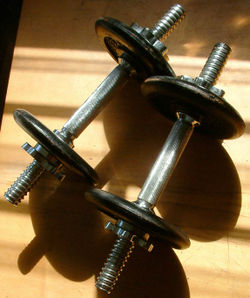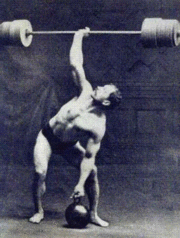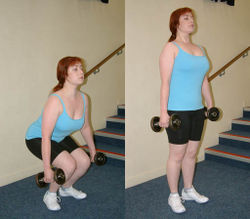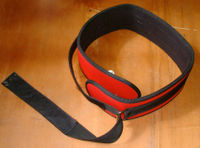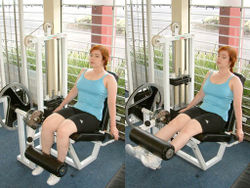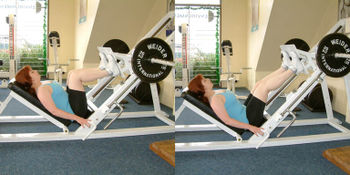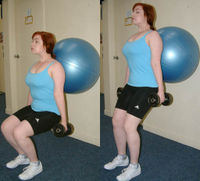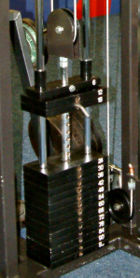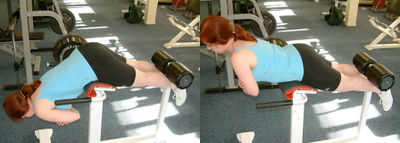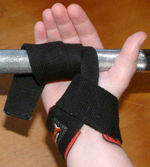Weight training
2007 Schools Wikipedia Selection. Related subjects: Health and medicine
Weight training is a form of exercise for developing the strength and size of skeletal muscles. It is a common type of strength training which uses the force of gravity (in the form of weighted bars, dumbells or weight stacks) to oppose the force generated by muscle through concentric or eccentric contraction.
Properly performed, weight training can provide significant functional benefits and improvement in overall health and well-being including increased bone, muscle, tendon and ligament strength, improved joint function, reduced potential for injury, improved cardiac function and elevated good cholesterol. In one common training method, the technique involves lifting progressively increasing amounts of weight, and uses a variety of exercises and types of equipment to target specific muscle groups. Weight training is primarily an anaerobic activity, although some proponents have adapted it to provide the benefits of aerobic exercise.
Weight training differs from bodybuilding, weightlifting, and powerlifting, which are sports rather than forms of exercise. Weight training, however, is often part of their training regimen.
History
Hippocrates explained the principle behind weight training when he wrote "that which is used develops, and that which is not used wastes away." Progressive resistance training dates back at least to Ancient Greece, when legend has it that wrestler Milo of Croton trained by carrying a newborn calf on his back every day until it was fully grown. Another Greek, the physician Galen, described strength training exercises using the halteres (an early form of dumbbell) in the 2nd century.
Another early device was the Indian club, which came from ancient Persia where it was called the "meels." It subsequently became popular during the 19th century, and has recently made a comeback in the form of the clubbell.
The dumbbell was joined by the barbell in the latter half of the 19th century. Early barbells had hollow globes that could be filled with sand or lead shot, but by the end of the century these were replaced by the plate-loading barbell commonly used today.
The 1960s saw the gradual introduction of exercise machines into the still-rare strength training gyms of the time. Weight training became increasingly popular in the 1980s, following the release of the bodybuilding movie Pumping Iron and the subsequent popularity of Arnold Schwarzenegger. Since the late 1990s increasing numbers of women have taken up weight training, influenced by programs like Body for Life: currently nearly one in five U.S. women engages in weight training on a regular basis.
Basic principles
The basic principle of weight training involves a manipulation of the number of reps, sets, tempo, exercise types and weight moved to cause desired increases in strength, endurance, size or shape. A repetition (or "rep") is the act of lifting and lowering a weight once in a controlled manner. A "set" consists of a series of repetitions performed continuously, without rests between reps. Different exercises target different muscles or muscles groups. The specific combinations of reps, sets, exercises and weight depends upon the aims of the individual performing the exercise; sets with fewer reps can be performed with heavier weights, but have a reduced impact on endurance.
According to popular theory:
- Sets of one to five repetitions primarily develop strength, with less impact on muscle size and none on endurance.
- Sets of six to twelve repetitions develop a balance of strength, muscle size and endurance.
- Sets of thirteen to twenty repetitions develop endurance, with some increases to muscle size and limited impact on strength.
- Sets of more than twenty repetitions are considered to be an aerobic exercise.
Individuals typically perform one to six sets per exercise, and one to three exercises per muscle group, with short breaks between each set. The duration of these breaks determines which energy system the body utilizes: for example, performing a series of exercises with little or no rest between them is referred to as " circuit training", and the body will draw most of its energy from the aerobic energy system (as opposed to the ATP-CP or glycogen systems, used in exercises with longer rests between sets).
It has been shown that for beginners multiple-set training offers minimal benefits over single set training with respect to either strength gain or muscle mass increase, but for the experienced athlete multiple-set systems are required for optimal progress. This is because beginners are unable to tap the full strength of the muscle; before they can use the full force ouput of a specific muscle, the nerves that innervate the muscle must be trained to fire at a high enough rate to cause tetanus, and contract all motor units available for the movement.
Training to achieve different performance goals (from "Supertraining" by Dr. M. C. Siff)
| Variable | Strength | Power | Hypertrophy | Endurance |
|---|---|---|---|---|
| Load (% of 1RM) | 80-100 | 70-100 | 60-80 | 40-60 |
| Reps per set | 1-5 | 1-5 | 8-15 | 25-60 |
| Sets per exercise | 4-7 | 3-5 | 4-8 | 2-4 |
| Rest between sets (mins) | 2-6 | 2-6 | 2-5 | 1-2 |
| Duration (seconds per set) | 5-10 | 4-8 | 20-60 | 80-150 |
| Speed per rep (% of max) | 60-100 | 90-100 | 60-90 | 60-80 |
| Training sessions per week | 3-6 | 3-6 | 5-7 | 8-14 |
Weights for each exercise should be chosen so that the desired number of repetitions can just be achieved. Each exercise should be performed according to its description; otherwise injury may result. This is known as "good form."
Progressive overload
In one common method, weight training uses the principle of progressive overload, in which the muscles are overloaded by attempting to lift at least as much weight as they are capable of. They respond by growing larger and stronger. This procedure is repeated with progressively heavier weights as the practitioner gains strength and endurance.
However, performing exercises at the absolute limit of one's strength (so-called " one rep max" lifts) is considered too risky for all but the most experienced practitioners, or novices under expert supervision. Moreover, most individuals wish to develop a combination of strength, endurance and muscle size. One repetition sets are not well suited to these aims. Practitioners therefore lift somewhat smaller (sub-maximal) weights, with more repetitions, to fatigue the muscle—and all fibres within that muscle—as required by the progressive overload principle.
Commonly, each exercise is continued to the point of momentary muscular failure. Contrary to widespread belief, this is not the point at which the individual thinks they cannot complete any more repetitions, but rather the first repetition that fails due to inadequate muscular strength. Training to failure is, however, a controversial topic. The proponents of High Intensity Training— Mike Mentzer, Arthur Jones and Ellington Darden—advise training to failure on every set. But other experts believe that this will lead to overtraining, and suggest training to failure only on the last set of an exercise. Some practitioners recommend finishing a set of repetitions just before the point of failure; e.g. if you can do a maximum of 12 reps with a given weight, only perform 11.
Weight training can be a very effective form of strength training because exercises can be chosen, and weights precisely adjusted to safely exhaust each individual muscle group after the specific numbers of sets and repetitions that have been found to be the most effective for the individual. Other strength training exercises lack the flexibility and precision that weights offer, and often cannot be safely taken to the point of momentary muscular failure.
Recovery
There are many theories as to why weight training creates muscle growth. One such theory is that this training causes microtrauma to the muscles. Muscles grow during the rest period following a workout by repairs to these areas of muscle, making them stronger than before. Weight training programs should therefore allow the muscles time to repair and grow, otherwise overtraining can occur. Therefore the individual should exercise caution in increasing the level of exertion. Muscle growth is normally completed within 36 to 96 hours, depending upon the intensity of the workout. Novices commonly work out every other day, often scheduling workouts on Mondays, Wednesdays and Fridays. As weight trainers grow fitter and stronger, it takes more intense workouts to fully challenge their muscles. More advanced practitioners may exercise specific muscle groups only every three or four days.
One solution to scheduling workouts around these needs is to split one's routine between several workouts, by exercising certain muscle groups on one day and the remainder on another. One common two-day split is the upper body — lower body split. Another is the front — back split, in which the pectorals, triceps and quadriceps are exercised on one day, and the lats, biceps and hamstrings on another. There are also three-day and four-day splits. By targeting different muscle groups, workouts can be scheduled more frequently than would otherwise be possible.
Intensity, volume, and frequency
Three important principles of weight training, as well as exercise in general, are intensity, volume and frequency. Intensity refers to the amount of force required to achieve the activity, and in this case, refers to the outright weight being lifted (lifting 20kg requires more force or intensity than lifting 10kg, regardless of how many reps/sets etc are done), volume refers to how much you do in a particular session, and includes the number of sets, reps and exercises you do for each muscle, whereas frequency refers to how many sessions per week you do. A good analogy is the exercise of running, with the intensity being how fast you run, the volume being how far you run, and the frequency being how many times a week you run.
These principles are important because they are all mutually conflicting, as the muscle only has so much strength and endurance, and takes time to recover due to microtrauma. Increasing one by any significant amount necessitates the decrease of the other two, eg. increasing weight means you can’t do as many reps, and will cause more damage, requiring more recovery time and therefore less workouts per week are possible. Trying to push too much intensity, volume and frequency will result in overtraining, and eventually lead to injury and other health issues such as chronic soreness and general lethargy (lack of energy) or even sickness. Therefore the high-medium-low formula should be used, with either intensity, volume, or frequency being high, one of the others being medium, and the other being low, following this chart as a guide:
| Type | Low | Med | High |
|---|---|---|---|
| Intensity (% of 1RM) | 10-40% | 50-70% | 80-100% |
| Volume(per muscle) | 1 exercise | 2 exercises | 3+ exercises |
| Sets | 1 set | 2-3 sets | 4+ sets |
| Reps | 1-6 reps | 8-15 reps | 20+ reps |
| Session Frequency | 1 p/w | 2-3 p/w | 4+ p/w |
Using examples from typical gym programs: doing a full body program, you would work each muscle as one exercise and do 2 sets of 12 reps (low volume), with an intensity of around 50-60% of 1RM each set (medium intensity), every second day (high frequency), which is typical of general fitness programs; doing each body part in a 3 day split, at 50-70% of 1RM (medium intensity), with 3 exercises and 3 sets of 10 reps (high volume), each muscle worked once a week (low frequency), which is typical of traditional hypertrophy programs; or 80-90% of 1RM (high intensity), 1-2 sets of 3-5 reps(low volume), 2 times per week (medium frequency), typical of muscular strength training. All of these programs are different examples of the high-medium-low formula, emphasizing one giving a different result, as the body adapts to specific demands.
Most people set the volume and frequency the same each week (eg. people plan to come to the gym 3 times per week, and do 2 sets of 12 reps each workout), and steadily increase the weight (increase intensity), however it may be equally or more beneficial for you to keep or decrease the weight, and increase volume or frequency (especially true to achieve hypertrophy).
Most supplements focus on improving a particular aspect, for instance taking creatine will give you the ability to do more sets (more volume) in a workout, while taking additional protein (or illegal steroids) will help muscle recovery, and so allow for more sessions per week (more frequency at the same level of intensity and volume). Adrenaline and other hormones may promote additional intensity by stimulating the body to lift additional weight (as well as the neuro-muscular stimulations that happen when in “fight-or-flight” mode, as the body activates more muscle fibres), so getting “revved up” before a workout can increase the maximum weight lifted, one of the reasons why bodybuilders and powerlifters grunt and rev themselves and their training partners up, whether this is more psychological or physiological though is debatable, as people can often lift more weight than they think they can.
Psychology definitely plays a role in training strategy. Someone who overtrains will feel less motivated to continue than someone who is undertraining, because the overtrainer begins to dislike his or her workout; it will seem too difficult or tiring, and this may cause a cycle of overtraining followed by long layoffs, which will give poor results. The undertrainer has no such discomfort and is likely to train more consistently and find a volume, frequency and intensity that is appropriate for their goals, even if they are not necessarily maximizing their potential.
Benefits
The benefits of weight training include greater muscular strength, improved muscle tone and appearance, increased endurance, enhanced bone density, and improved cardiovascular fitness.
Many people take up weight training to improve their physical attractiveness. Most men can develop substantial muscles; most women lack the testosterone to do this, but they can develop a firm, "toned" (see below) physique, and they can increase their strength by the same proportion as that achieved by men (but usually from a significantly lower starting point). Ultimately an individual's genetics dictate the response to weight training stimuli.
The body's basal metabolic rate increases with increases in muscle mass, which promotes long-term fat loss and helps dieters avoid yo-yo dieting. Moreover, intense workouts elevate the metabolism for several hours following the workout, which also promotes fat loss.
Weight training also provides functional benefits. Stronger muscles improve posture, provide better support for joints, and reduce the risk of injury from everyday activities. Older people who take up weight training can prevent some of the loss of muscle tissue that normally accompanies aging—and even regain some functional strength—and by doing so become less frail. They may be able to avoid some types of physical disability. Weight-bearing exercise also helps to prevent osteoporosis. The benefits of weight training for older people have been confirmed by studies of people who began engaging in it even in their 80s and 90s.
Stronger muscles improve performance in a variety of sports. Sport-specific training routines are used by many competitors. These often specify that the speed of muscle contraction during weight training should be the same as that of the particular sport.
When performed properly and at sufficient intensity, weight training provides an excellent stimulus to the cardiovascular system. The heart and lungs support the muscular system; as one taxes the muscles, the systems that support them are taxed. Exercise physiologists believe that aerobics training is a better cardiovascular stimulus due to their observation of maximal oxygen uptake estimates. Central catheter monitoring during resistance training reveals increased cardiac output, thus illustrating the strength training's potential for cardiovascular exercise.
Other than the visible benefits, weight training can play a significant role in improving mental health through improved mood, self-concept and body satisfaction. One side-effect of general intense exercise is that it increases levels of dopamine, serotonin and norepinephrine, which can help to improve mood and counter feelings of depression. Individuals who exercise at least two to three times a week experience significantly less depression, anger, and stress than those exercise less frequently or not at all and regular exercisers perceive their health and fitness to be better than less frequent exercisers.
Common concerns
Is weight training the same as bodybuilding?
Although weight training is similar to bodybuilding, they have quite different goals. Bodybuilders compete in bodybuilding competitions, so they train to maximize their muscular size and develop extremely low levels of body fat. In contrast, most weight trainers train to improve their strength and anaerobic endurance while not giving special attention to reducing body fat below normal. Weight trainers tend to focus on compound exercises to build basic strength, whereas bodybuilders often use isolation exercises to visually separate their muscles, and to improve muscular symmetry.
However, the bodybuilding community has been the source of many of weight training's principles, techniques, vocabulary, and customs.
Is nutrition relevant for weight trainers?
Most people think of dieting in terms of weight loss, but weight trainers can also adjust their diet to improve the results from their workouts. Adequate protein is required for building skeletal muscle. Various sources advise weight trainers to consume a high protein diet with anywhere from 0.6 to 1.5 g of protein per pound of body weight per day (1.4 to 3.3 g per kg). Protein that is not needed for cell growth and repair nor consumed for energy is converted by the liver into fat, which is then stored in the body. Some people believe that a high protein diet entails risk of kidney damage, but studies have shown that kidney problems only occur in people with previous kidney disease.
A light balanced meal consumed prior to the workout (usually one to two hours beforehand) ensures that adequate energy and amino acids are available to perform the intense bout of exercise. Water is consumed throughout the course of the workout to prevent poor performance due to dehydration. A protein shake is often consumed immediately following the workout, because both protein uptake and protein usage are increased at this time. Glucose (or another simple sugar) is often consumed as well since this quickly replenishes any glycogen lost during the exercise period (see Gainer). Some weight trainers also take supplements (such as creatine) to aid muscle growth. However, the effectiveness of some products is disputed and others are potentially harmful.
Do women who train with weights look "bulky"?
Very few women are able to develop large muscles regardless of the program they follow; they simply lack the testosterone required to achieve this. Normally the most that can be achieved is a look similar to that of a fitness model. Muscle is denser than fat, so someone who builds muscle while keeping the same body weight will look slimmer.
The results obtained by female bodybuilders are extremely atypical: they are self-selected for their genetic ability to build muscle, perform enormous amounts of exercise, their musculature is exaggerated by very low body fat and like many male bodybuilders their results may be enhanced by anabolic steroids. Unless a woman dedicates her life to bodybuilding, she will not achieve the same results as a professional bodybuilder.
Are light, high-repetition exercises effective for "toning" muscles?
Some weight trainers perform light, high-repetition exercises in an attempt to "tone" their muscles without increasing their size. This comes from misunderstanding the meaning of the word " tone." What most people refer to as a toned physique is one that combines reasonable muscular size with moderate levels of body fat. The use of the word "tone" in this sense is inaccurate: a more appropriate term would be "definition".
Muscle tone is a physiologic term that refers to the constant, low-frequency contractions that occur in all muscles all the time, even at "rest", which prepare them for future activity. This continuous slight tension in torso muscles contributes to maintaining good posture. High-repetition exercises should increase muscle size, but will not improve the latter type of muscle "tone". Even performed as aerobic exercises they will have limited benefit, since aerobic exercise is most effective when it engages the whole body.
To define muscles requires a combination of weight training to increase muscle size and cardiovascular training to reduce bodyfat levels.
Is weight training safe for children?
Orthopaedic specialists used to recommend that children avoid weight training because the growth plates on their bones might be at risk, but recent studies have shown that this concern is unfounded. The very rare reports of growth plate fractures in children who trained with weights occurred as a result of inadequate supervision, improper form or excess weight. "Growth plate injuries have not occurred in any youth strength training study that followed established training guidelines." The National Strength and Conditioning Association also confirms that "a properly designed and supervised resistance training programme is safe for children."
Young children must be supervised around weight training equipment. Like adults, they may be injured if a weight is dropped, or if they perform an exercise incorrectly. Children may also forget to follow the safety guidelines, or be tempted to act irresponsibly.
Can weight training help me slim?
Yes, but not via the low weight/high repetition approach that is usually used. Five minutes of crunches will expend only a small fraction of the energy used up in five minutes of running, because the abdominal muscles are so much smaller than the leg muscles. Instead, high weight/low rep exercises can be used to maintain (and possibly even increase) the body's muscle mass while dieting. This helps to prevent the metabolic slowdown that otherwise often limits the effect of dieting and causes post-diet weight gain.
Safety
Weight training can be one of the safest forms of exercise, especially when the movements are slow, controlled, and carefully defined. However, as with any form of exercise, improper execution can result in injury. When the exercise becomes difficult towards the end of a set, there is a temptation to "cheat", i.e. to use poor form to recruit other muscle groups to assist the effort. This may shift the effort to weaker muscles that cannot handle the weight. For example, the squat and the deadlift are used to exercise the largest muscles in the body—the leg and buttock muscles—so they require substantial weight. Beginners are tempted to round their back while performing these exercises. This causes the weaker lower back muscles to support much of the weight, which can result in serious lower back injuries. To avoid such problems, weight training exercises must be performed correctly. Hence the saying: "train, don't strain".
An exercise should be halted if marked or sudden pain is felt, to prevent further injury. However, not all discomfort indicates injury. Weight training exercises are brief but very intense, and many people are unaccustomed to this level of effort. The expression "no pain, no gain" refers to the discomfort expected from such vigorous effort. It does NOT suggest ignoring the more severe pain that comes from injury.
Discomfort can arise from other factors. Individuals who perform large numbers of repetitions, sets and exercises for each muscle group may experience lactic acid build-up in their muscles. This is experienced as a burning sensation in the muscle, but it is perfectly harmless. These individuals may also experience a swelling sensation in their muscles from increased blood flow (the "pump"), which is also harmless.
Beginners are advised to build up slowly to a weight training programme. Untrained individuals may have some muscles that are comparatively stronger than others. An injury can result if, in a particular exercise, the primary muscle is stronger than its stabilising muscles. Building up slowly allows muscles time to develop appropriate strengths relative to each other. This can also help to minimise delayed onset muscle soreness. A sudden start to an intense programme can cause significant muscular soreness. Unexercised muscles contain cross-linkages that are torn during intense exercise.
Weight trainers commonly spend 5 to 20 minutes warming up their muscles with aerobic exercise before starting a workout. They also stretch muscles after they have been exercised. The exercises are performed at a steady pace, taking at least two to four seconds to lift and lower the weight, to avoid jerks that can damage muscles and joints.
Exercises where a barbell is held above the body, such as the squat or the bench press, are normally performed inside a squat cage, which can catch the bar, or in the presence of one or more spotters, who can safely re-rack the barbell at the end of the set if the weight trainer is unable to do so.
Anyone beginning an intensive physical training programme is typically advised to consult a physician, because of possible undetected heart or other conditions for which such activity is contraindicated.
There have been mixed reviews regarding the use of weightlifting belts and other devices, such as lifting straps. Critics claim that they allow the lifter to use more weight than they should. In addition, the stabiliser muscles in the lower back and gripping muscles in the forearms receive less benefit from the exercises.
Types of exercises
Isotonic, isometric and plyometric exercises
These terms combine the prefix "iso" (meaning "same") with "tonic" (strength) and "metric" (distance). In "isotonic" exercises the force applied to the muscle does not change (while the length of the muscle decreases or increases) while in "isometric" exercises the length of the muscle does not change.
Weight training is primarily an isotonic form of exercise, as the force produced by the muscle to push or pull weighted objects should not change (though in practice the force produced does decrease as muscles fatigue). Any object can be used for weight training, but dumbbells, barbells and other specialised equipment are normally used because they can be adjusted to specific weights and are easily gripped. Many exercises are not strictly isotonic because the force on the muscle varies as the joint moves through its range of motion. Movements can become easier or harder depending on the angle of muscular force relative to gravity - in example, a standard bicep curl becomes easier as the hand approaches the shoulderas more of the load is taken by the structure of the elbow. Certain machines such as the Nautilis involve special adaptations to keep resistance constant irrespective of the joint angle.
Some forms of weight training use isometric contractions to further stress the muscles after or during a period of isotonic exercise. In this case the muscles flex and hold a stationary position, and no movement of a load takes place. Often this is used to increase muscular strength at specific joint angles, to get over 'sticking points' in an exercise.
Plyometric exercises exploits the stretch-shortening cycle of muscles to enhance the myotatic (stretch) reflex. This involves rapid alternation of lengthening and shortening of muscle fibers against a resistance. The resistance involved is often a weighted object such as a medicine ball, but can also be the body itself as in jumping exercises. Plyometrics is used to develop explosive speed, and focuses on maximal power instead of maximal strength by compressing the force of muscular contraction into as short a period as possible, and may be used to improve the effectiveness of a boxer's punch, or to increase the vertical jumping ability of a basketball player.
Isolation exercises versus compound exercises
An isolation exercise is one where the movement is restricted to one joint and one muscle group. For example, the leg extension is an isolation exercise for the quadriceps. The other muscle groups are only minimally involved—they just help the individual maintain a stable posture—and movement occurs only around the knee joint.
Compound exercises work several muscle groups at once, and include movement around two or more joints. For example, in the leg press movement occurs around the hip, knee and ankle joints. This exercise is primarily used to develop the quadriceps, but it also involves the hamstrings, glutes and calves.
Compound exercises are generally similar to the ways that people naturally push, pull and lift objects, whereas isolation exercises often feel a little unnatural.
Each type of exercise has its uses. Compound exercises build the basic strength that is needed to perform everyday pushing, pulling and lifting activities. Isolation exercises are useful for "rounding out" a routine, by directly exercising muscle groups that cannot be fully exercised in the compound exercises.
The type of exercise performed also depends on the individual's goals. Those who seek to increase their performance in sports would focus mostly on compound exercises, with isolation exercises being used to strengthen just those muscles that are holding the athlete back. Similarly, a powerlifter would focus on the specific compound exercises that are performed at powerlifting competitions. However, those who seek to improve the look of their body without necessarily maximising their strength gains (including bodybuilders) would put more of an emphasis on isolation exercises.
Free weights versus exercise machines
Free weights are dumbbells and barbells. Unlike exercise machines, they do not constrain users to specific, fixed movements, and therefore require more effort from the individual's stabilizer muscles. It is often argued that free weight exercises are superior for precisely this reason. As exercise machines can go some way toward preventing poor form, they are somewhat safer than free weights for novice trainees. Moreover, since users need not concentrate so much on maintaining good form, they can focus more on the effort they are putting into the exercise. However, most athletes, bodybuilders and serious fitness enthusiasts prefer to use compound free weight exercises to gain functional strength.
Some free weight exercises can be performed while sitting or lying on a Swiss ball. This makes it more difficult to maintain good form, which helps to exercise the deep torso muscles that are important for maintaining a good posture.
There are a number of exercise machines that are commonly found in neighbourhood gyms. The Smith machine is a barbell that is constrained to move only vertically upwards and downwards. The cable machine consists of two weight stacks separated by 2.5 metres, with cables running through adjustable pulleys (that can be fixed at any height) to various types of handles. There are also exercise-specific weight machines such as the leg press. A multigym includes a variety of exercise-specific mechanisms in one apparatus.
One limitation of many free weight exercises and exercise machines is that the muscle is working maximally against gravity during only a small portion of the lift. Some exercise-specific machines feature an oval cam (first introduced by Nautilus) which varies the resistance so that the resistance, and the muscle force required, remains constant throughout the full range of motion of the exercise.
Aerobic exercise versus anaerobic exercise
Strength training exercise is primarily anaerobic. Even while training at a lower intensity (training loads of ~20-RM), anaerobic glycolysis is still the major source of power, although aerobic metabolism makes a small contribution. Weight training is commonly perceived as anaerobic exercise, because one of the more common goals is to increase strength by lifting heavy weights. Other goals such as rehabilitation, weight loss, body shaping, and bodybuilding often use lower weights, adding aerobic character to the exercise.
Except in the extremes, a muscle will fire fibres of both the aerobic or anaerobic types on any given exercise, in varying ratio depending on the load on the intensity of the contraction. In the aerobic regime, the blood and intracellular processes can maintain a supply of fuel and oxygen, and continual repetition of the motion will not cause the muscle to fail.
Circuit weight training is a form of exercise that uses a number of weight training exercise sets separated by short intervals. The cardiovascular effort to recover from each set serves a function similar to an aerobic exercise, but this is not the same as saying that a weight training set is itself an aerobic process.
Exercises for specific muscle groups
Weight trainers commonly divide the body's individual muscles into ten major muscle groups. These do not include the hip, neck and forearm muscles, which are rarely trained in isolation. The most common exercises for these muscle groups are listed below. (Videos of these and other exercises are available at exrx.net and from the University of Wisconsin.) The sequence shown below is one possible way to order the exercises. The large muscles of the lower body are normally trained before the smaller muscles of the upper body, because these first exercises require more mental and physical energy. The core muscles of the torso are trained before the shoulder and arm muscles that assist them. Exercises often alternate between "pushing" and "pulling" movements to allow their specific supporting muscles time to recover. The stabilising muscles in the waist should be trained last.
| Lower body 1. Quadriceps (front of legs) Compound exercises for the quadriceps also involve the glutes (buttocks), hamstrings and calves.
2. Hamstrings (back of legs)
3. Calves
|
Upper body 4. Pectorals (chest) Compound exercises for the pectorals also involve the triceps and front deltoids.
5. Lats (upper back) Compound exercises for the lats also involve the biceps and rear deltoids.
6. Deltoids and Trapezius (shoulders) Compound exercises for the shoulders also involve the arm muscles.
|
Arms 7. Triceps (back of arms)
8. Biceps (front of arms)
Waist 9. Abdominals (belly) Compound exercises for the abdominals also involve the hip flexors.
10. Lower back Some compound exercises for the legs also involve the lower back.
|
Advanced techniques
A number of techniques have been developed to make weight training exercises more intense, and thereby potentially increase the rate of progress:
Set structure
- Drop sets
- Drop sets do not end at the point of momentary muscular failure, but continue with progressively lighter weights.
- Pyramid sets
- In a pyramid the weight is first increased, and then decreased over a series of sets. A full pyramid typically includes five sets of approximately 12, 10, 8, 10 and 12 reps. The first two sets are performed with light to medium weights to warm up the muscles. The middle set is the work set, and uses the heaviest weight possible. The last two sets are drop sets, and further fatigue the muscle with progressively lighter weights. This technique provides a combination of volume and intensity, and is therefore popular with bodybuilders. However, the full pyramid may be too much for a beginner to handle, so it is only recommended for experienced trainers.
- Burnouts
- Burnouts combine pyramids and drop sets, working up to higher weights with low reps and then back down to lower weights and high reps.
- Diminishing set
- The diminishing set method is where a weight is chosen that can be lifted for 20 reps in one set, and then 70 repetitions are performed in as few sets as possible.
- Rest-pause (heavy singles)
- Rest-pause heavy singles are performed at or near 1RM, with ten to twenty seconds of rest between each lift. The lift is repeated six to eight times. It is generally recommended to use this method infrequently.
Combined sets
- Supersets
- Supersets combine two or more exercises with similar motions to maximize the amount of work of an individual muscle or group of muscles. The exercises are performed with no rest period between the exercises. An example would be doing bench press, which predominantly works the pectoralis and triceps muscles, and then moving to an exercise that works just the triceps such as the triceps extension or the pushdown.
- Push-pull supersets
- Push-pull supersets are similar to regular supersets, but exercises are chosen which work opposing muscle groups. This is especially popular when applied to arm exercises, for example by combining biceps curls with the triceps pushdown. Other examples include the shoulder press and lat pulldown combination, and the bench press and wide grip row combination.
- Pre-exhaustion
- Pre-exhaustion combines an isolation exercise with a compound exercise for the same muscle group. The isolation exercise first exhausts the muscle group, and then the compound exercise uses the muscle group's supporting muscles to push it further than would otherwise be possible. For example, the triceps muscles normally help the pectorals perform their function. But in the "bench press" the weaker triceps often fails first, which limits the impact on the pectorals. By preceding the bench press with the pec flye, the pectorals can be pre-exhausted so that both muscles fail at the same time, and both benefit equally from the exercise.
- Breakdowns
- Breakdowns were developed by Fred Hatfield and Mike Quinn to work the different types of muscle fibers for maximum stimulation. Three different exercises that work the same muscle group are selected, and used for a superset. The first exercise uses a heavy weight (~85% of 1 rep max) for around five reps, the second a medium weight (~70% of 1 rep max) for around twelve reps, and finally the third exercise is performed with a light weight (~50% of 1 rep max) for twenty to thirty reps, or even lighter (~40% of 1 rep max) for forty or more reps. ( Going to failure is discouraged.) The entire superset is performed three times.
Beyond failure
- Forced reps
- Forced reps occur after momentary muscular failure. An assistant provides just enough help to get the weight trainer past the sticking point of the exercise, and allow further repetitions to be completed. Weight trainers often do this when they are spotting their exercise partner. With some exercises forced reps can be done without a training partner. For example, with one-arm biceps curls the other arm can be used to assist the arm that is being trained.
- Cheat reps
- Cheating is a deliberate compromise of form in order to achieve further reps. Cheating has the advantage that it can be done without a training partner, unlike forced reps.
- Rest-pause (post-failure)
- After a normal set of 6-8 reps (to failure), the weight is re-racked and the trainer takes 10-15 deep breaths, and then performs one more repetition. This process can be repeat for two further repetitions. The twenty-rep squat is another, similar approach, in that it follows a 12-15 rep set of squats with individual rest-pause reps, up to a total of 20 reps.
- Negative reps
- Negatives are performed with much heavier weights. Assistants lift the weight, and then the weight trainer attempts to resist its downward progress. Alternatively, an individual can use an exercise machine for negatives by lifting the weight with both arms or legs, and then lowering it with only one. Or they can simply lower weights more slowly than they lift them: for example, by taking two seconds to lift each weight and four seconds to lower it.
- Partial reps
- Partial reps, as the name implies, involves movement through only part of the normal path of an exercise. Partial reps can be performed with heavier weights. Usually, only the easiest part of the repetition is attempted.
- Burns
- Burns involve mixing partial reps into a set of full range reps in order to increase intensity. The partials can be performed at any part of the exercise movement, depending on what works best for the particular exercise. Also, the partials can either be added after the end of a set or in some alternating fashion with the full range reps. For example, after performing a set of biceps curls to failure, an individual would cheat the bar back to the most contracted position, and then perform several partial reps.
- X-reps
- X-reps are a variation of burns, but X-reps always occur after momentary muscular failure. After the last full repetition, an isometric contraction at the point of maximum force is combined with a series of small pulsing movements to further stress the muscles. However, in a 1997 article Steve Holman states that "X-Rep training is simply placing a muscle in its completely contracted position, or close to it, against resistance and holding it there until the muscle can no longer contract. Once you achieve fatigue overload, you slowly lower the weight through the eccentric range of motion, and the set is complete."
Other techniques
- Super slow
- Super slow repetitions are performed with lighter weights. The lifting and lowering phases of each repetition take 10 seconds or more.
- Timed rests
- By strictly controlling the rest periods between reps and sets a trainer can reduce their level of blood oxygenation, which helps to increase the stress on the muscles.
- Wrist straps
- Wrist straps (lifting straps) are sometimes used to assist in gripping very heavy weights. They are particularly useful for the deadlift. Some lifters, however, avoid using wrist straps in order to develop their grip strength. Wrist straps can allow a lifter initially to use more weight than they might be able to handle safely for an entire set. They can also place potentially harmful stress on the bones of the wrist. Instead, wrist curls and reverse wrist curls can be done to improve grip strength.
